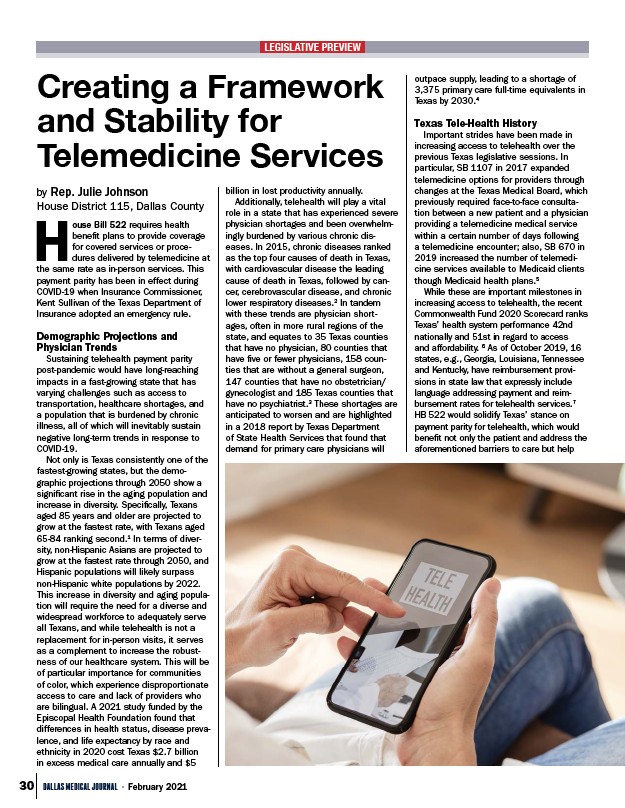
House Bill 522 requires health
benefit plans to provide coverage
for covered services or procedures
delivered by telemedicine at
the same rate as in-person services. This
payment parity has been in effect during
COVID-19 when Insurance Commissioner,
Kent Sullivan of the Texas Department of
Insurance adopted an emergency rule.
Demographic Projections and
Physician Trends
Sustaining telehealth payment parity
post-pandemic would have long-reaching
impacts in a fast-growing state that has
varying challenges such as access to
transportation, healthcare shortages, and
a population that is burdened by chronic
illness, all of which will inevitably sustain
negative long-term trends in response to
COVID-19.
Not only is Texas consistently one of the
fastest-growing states, but the demographic
projections through 2050 show a
significant rise in the aging population and
increase in diversity. Specifically, Texans
aged 85 years and older are projected to
grow at the fastest rate, with Texans aged
65-84 ranking second.1 In terms of diversity,
non-Hispanic Asians are projected to
grow at the fastest rate through 2050, and
Hispanic populations will likely surpass
non-Hispanic white populations by 2022.
This increase in diversity and aging population
will require the need for a diverse and
widespread workforce to adequately serve
all Texans, and while telehealth is not a
replacement for in-person visits, it serves
as a complement to increase the robustness
of our healthcare system. This will be
of particular importance for communities
of color, which experience disproportionate
access to care and lack of providers who
are bilingual. A 2021 study funded by the
Episcopal Health Foundation found that
differences in health status, disease prevalence,
and life expectancy by race and
ethnicity in 2020 cost Texas $2.7 billion
in excess medical care annually and $5
30 DALLAS MEDICAL JOURNAL • February 2021
billion in lost productivity annually.
Additionally, telehealth will play a vital
role in a state that has experienced severe
physician shortages and been overwhelmingly
burdened by various chronic diseases.
In 2015, chronic diseases ranked
as the top four causes of death in Texas,
with cardiovascular disease the leading
cause of death in Texas, followed by cancer,
cerebrovascular disease, and chronic
lower respiratory diseases.2 In tandem
with these trends are physician shortages,
often in more rural regions of the
state, and equates to 35 Texas counties
that have no physician, 80 counties that
have five or fewer physicians, 158 counties
that are without a general surgeon,
147 counties that have no obstetrician/
gynecologist and 185 Texas counties that
have no psychiatrist.3 These shortages are
anticipated to worsen and are highlighted
in a 2018 report by Texas Department
of State Health Services that found that
demand for primary care physicians will
outpace supply, leading to a shortage of
3,375 primary care full-time equivalents in
Texas by 2030.4
Texas Tele-Health History
Important strides have been made in
increasing access to telehealth over the
previous Texas legislative sessions. In
particular, SB 1107 in 2017 expanded
telemedicine options for providers through
changes at the Texas Medical Board, which
previously required face-to-face consultation
between a new patient and a physician
providing a telemedicine medical service
within a certain number of days following
a telemedicine encounter; also, SB 670 in
2019 increased the number of telemedicine
services available to Medicaid clients
though Medicaid health plans.5
While these are important milestones in
increasing access to telehealth, the recent
Commonwealth Fund 2020 Scorecard ranks
Texas’ health system performance 42nd
nationally and 51st in regard to access
and affordability. 6 As of October 2019, 16
states, e.g., Georgia, Louisiana, Tennessee
and Kentucky, have reimbursement provisions
in state law that expressly include
language addressing payment and reimbursement
rates for telehealth services.7
HB 522 would solidify Texas’ stance on
payment parity for telehealth, which would
benefit not only the patient and address the
aforementioned barriers to care but help
LEGISLATIVE PREVIEW
Creating a Framework
and Stability for
Telemedicine Services
by Rep. Julie Johnson
House District 115, Dallas County